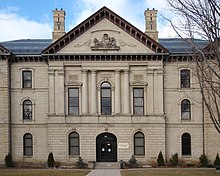
Brantford is a city in Ontario, Canada, founded on the Grand River in Southwestern Ontario. It is surrounded by Brant County, but is politically separate with a municipal government of its own that is fully independent of the county's municipal government.

The Golden Horseshoe is a secondary region of Southern Ontario, Canada, which lies at the western end of Lake Ontario, with outer boundaries stretching south to Lake Erie and north to Lake Scugog, Lake Simcoe and Georgian Bay of Lake Huron. The region is the most densely populated and industrialized in Canada. Based on the 2021 census, with a population of 7,759,635 people in its core and 9,765,188 in its greater area, the Golden Horseshoe accounts for over 20 percent of the population of Canada and more than 54 percent of Ontario's population. It is part of the Quebec City–Windsor Corridor, itself part of the Great Lakes megalopolis.

Northumberland County is an upper-tier municipality situated on the north shore of Lake Ontario, east of Toronto in Central Ontario. The Northumberland County headquarters are located in Cobourg.
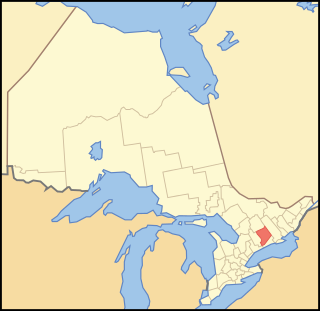
Peterborough County is located in Southern Ontario, Canada. The county seat is The City of Peterborough, which is independent of the county.

Burford is a rural community and is part of the County of Brant, in central southwestern Ontario. It has 1,058 residents. It is located eight kilometres west of the City of Brantford along Highway 53, and seventy kilometres east of London, Ontario. It is approximately 100 km southwest of Toronto.
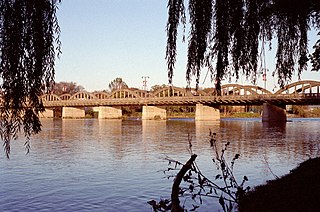
Haldimand County is a rural city-status single-tier municipality on the Niagara Peninsula in Southern Ontario, Canada, on the north shore of Lake Erie, and on the Grand River. Despite its name, it is no longer a county by definition, as all municipal services are handled by a single level of government. Municipal offices are located in Cayuga.

Norfolk County is a rural single-tier municipality on the north shore of Lake Erie in Southwestern Ontario, Canada with a 2016 population of 67,490. Despite its name, it is no longer a county by definition, as all municipal services are handled by a single level of government. The largest community in Norfolk County is Simcoe, whose 2016 population was 13,922. The other population centres are Port Dover, Delhi, Waterford and Port Rowan, and there are many smaller communities. For several years in the late 20th century, the county was merged with Haldimand County but the merged entity was dissolved in 2000.
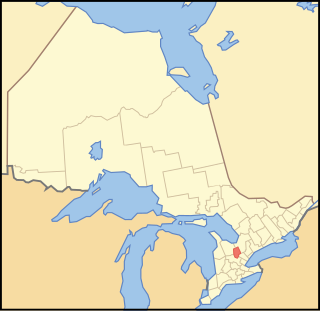
Dufferin County is a county and census division located in Central Ontario, Canada. The county seat is Orangeville, and the current Warden is Wade Mills. The current chief administrative officer is Sonya Pritchard. Dufferin covers an area of 1,486.31 square kilometres (573.87 sq mi), and its population was 61,735 at the time of the 2016 Census.

Six Nations is demographically the largest First Nations reserve in Canada. As of the end of 2017, it has a total of 27,276 members, 12,848 of whom live on the reserve. These nations are the Mohawk, Cayuga, Onondaga, Oneida, Seneca and Tuscarora. Some Lenape live in the territory as well.

Cambridge is a federal electoral district in Ontario, Canada, that has been represented in the House of Commons of Canada since 1979.

Hagersville is a community in Haldimand County, Ontario in Canada.

Brantford—Brant is a federal electoral district in Ontario, Canada, that has been represented in the House of Commons of Canada from 1904 to 1949 and since 1968.
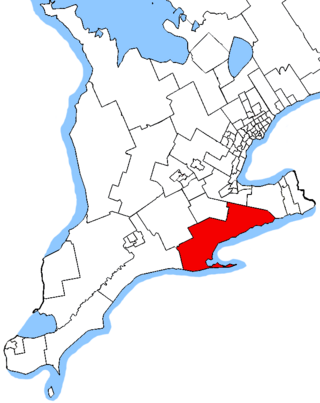
Haldimand—Norfolk is a federal electoral district in Ontario, Canada, that has been represented in the House of Commons of Canada from 1979 to 1997, and since 2004. The current Member of Parliament (MP) is Conservative Leslyn Lewis.

Oxford is a federal electoral district in Ontario, Canada, that has been represented in the House of Commons of Canada since the 1935 election.
Foreign-born people are those born outside of their country of residence. Foreign born are often non-citizens, but many are naturalized citizens of the country in which they live, and others are citizens by descent, typically through a parent.

The Township of Alnwick/Haldimand is a township in central Ontario, Canada, in Northumberland County, situated between Lake Ontario and Rice Lake. It was formed in 2001 by the merger of Alnwick Township in the north and Haldimand Township in the south. Alderville First Nation is an autonomously governed First Nation contained within the township boundaries, in two non-contiguous sections along County Roads 45 and 18.

Ontario, one of the 13 provinces and territories of Canada, is located in east-central Canada. It is Canada's most populous province by a large margin, accounting for nearly 40 percent of all Canadians, and is the second-largest province in total area. Ontario is fourth-largest in total area when the territories of the Northwest Territories and Nunavut are included. It is home to the nation's capital city, Ottawa, and the nation's most populous city, Toronto.
Haldimand—Norfolk—Brant was a provincial electoral district in central Ontario, Canada that elected one Member of the Legislative Assembly of Ontario. It was created in 1999 from Norfolk and Brant—Haldimand. It was abolished in 2007 into Haldimand—Norfolk and Brant.
Cainsville is a community straddling the boundary of Brantford and Brant County in Ontario, Canada.

In 2021, the population of the city of Ottawa was 1,017,449. The population of the census metropolitan area, Ottawa-Gatineau, was 1,488,307.


